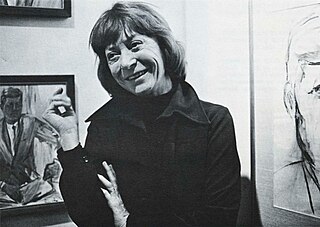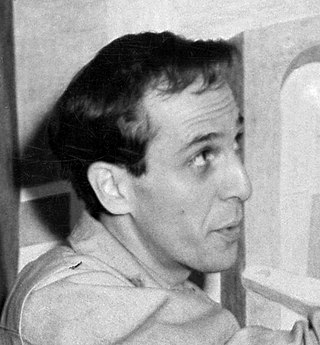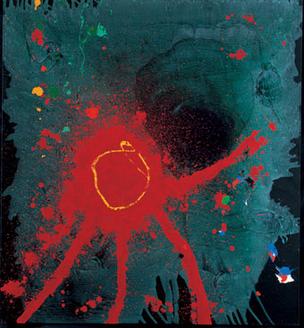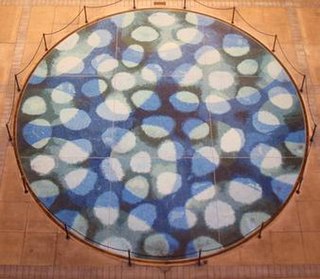T. Bill Andrews is an American abstract impressionist painter, author and lawyer.
T. Bill Andrews is an American abstract impressionist painter, author and lawyer.
T. Bill Andrews was born Thomas William Andrews in Kansas in 1958. [1]
Andrews served in the U.S. Navy Nuclear Power Program before enrolling as an undergraduate member of the University of Iowa Writers' Workshop in the mid-1980s. [2] It was while at the Writers' Workshop that he adopted his pen name "T. Bill" (sometimes "T-Bill").[ citation needed ] He received his doctorate from Yale University, writing a fictionalized memoir of his experiences at Yale entitled Power Ties. [3]
After graduating, Andrews worked as an attorney in various capacities, [4] most recently as Assistant Attorney General of Iowa. [2]
Andrews paints landscapes, florals and representational and architectural pieces in the style of impressionism, as well as figurative studies, but his primary emphasis is on large-format action painting in a style known as abstract expressionism. [1] Long retired, his current painting studio fronts a large horse meadow.[ citation needed ]

Paul Jackson Pollock was an American painter. A major figure in the abstract expressionist movement, Pollock was widely noticed for his "drip technique" of pouring or splashing liquid household paint onto a horizontal surface, enabling him to view and paint his canvases from all angles. It was called all-over painting and action painting, since he covered the entire canvas and used the force of his whole body to paint, often in a frenetic dancing style. This extreme form of abstraction divided critics: some praised the immediacy of the creation, while others derided the random effects.

Expressionism is a modernist movement, initially in poetry and painting, originating in Northern Europe around the beginning of the 20th century. Its typical trait is to present the world solely from a subjective perspective, distorting it radically for emotional effect in order to evoke moods or ideas. Expressionist artists have sought to express the meaning of emotional experience rather than physical reality.
Abstract expressionism in the United States emerged as a distinct art movement in the immediate aftermath of World War II and gained mainstream acceptance in the 1950s, a shift from the American social realism of the 1930s influenced by the Great Depression and Mexican muralists. The term was first applied to American art in 1946 by the art critic Robert Coates. Key figures in the New York School, which was the center of this movement, included such artists as Arshile Gorky, Jackson Pollock, Franz Kline, Mark Rothko, Norman Lewis, Willem de Kooning, Adolph Gottlieb, Clyfford Still, Robert Motherwell, Theodoros Stamos and Lee Krasner among others.

Visual art of the United States or American art is visual art made in the United States or by U.S. artists. Before colonization, there were many flourishing traditions of Native American art, and where the Spanish colonized Spanish Colonial architecture and the accompanying styles in other media were quickly in place. Early colonial art on the East Coast initially relied on artists from Europe, with John White the earliest example. In the late 18th and early 19th centuries, artists primarily painted portraits, and some landscapes in a style based mainly on English painting. Furniture-makers imitating English styles and similar craftsmen were also established in the major cities, but in the English colonies, locally made pottery remained resolutely utilitarian until the 19th century, with fancy products imported.
Action painting, sometimes called "gestural abstraction", is a style of painting in which paint is spontaneously dribbled, splashed or smeared onto the canvas, rather than being carefully applied. The resulting work often emphasizes the physical act of painting itself as an essential aspect of the finished work or concern of its artist.
The New York School was an informal group of American poets, painters, dancers, and musicians active in the 1950s and 1960s in New York City. They often drew inspiration from surrealism and the contemporary avant-garde art movements, in particular action painting, abstract expressionism, jazz, improvisational theater, experimental music, and the interaction of friends in the New York City art world's vanguard circle.

Jack Tworkov was an American abstract expressionist painter.

Richard Diebenkorn was an American painter and printmaker. His early work is associated with abstract expressionism and the Bay Area Figurative Movement of the 1950s and 1960s. In the late 1960s he began his extensive series of geometric, lyrical abstract paintings. Known as the Ocean Park paintings, these paintings were instrumental to his achievement of worldwide acclaim. Art critic Michael Kimmelman described Diebenkorn as "one of the premier American painters of the postwar era, whose deeply lyrical abstractions evoked the shimmering light and wide-open spaces of California, where he spent virtually his entire life."

Elaine Marie Catherine de Kooning was an Abstract Expressionist and Figurative Expressionist painter in the post-World War II era. She wrote extensively on the art of the period and was an editorial associate for Art News magazine.
Neo-expressionism is a style of late modernist or early-postmodern painting and sculpture that emerged in the late 1970s.. Neo-expressionists were sometimes called Transavantgarde, Junge Wilde or Neue Wilden. It is characterized by intense subjectivity and rough handling of materials.

Philip Guston was a Canadian American painter, printmaker, muralist and draftsman. "Guston worked in a number of artistic modes, from Renaissance-inspired figuration to formally accomplished abstraction," and is now regarded as one of the "most important, powerful, and influential American painters of the last 100 years." He frequently depicted racism, antisemitism, fascism and American identity, as well as—especially in his later most cartoonish and mocking work—the banality of evil. In 2013, Guston's painting To Fellini set an auction record at Christie's when it sold for $25.8 million.

Lyrical abstraction is either of two related but distinct trends in Post-war Modernist painting:
Nicholas Marsicano was an American painter and teacher of the New York School. His work was primarily based on the female figure.

Tadashi Sato was an American artist. He was born in Kaupakalua on the Hawaiian island of Maui. His father had been a pineapple laborer, merchant, and calligrapher, and Tadashi's grandfather was a sumi-e artist.

New York Figurative Expressionism is a visual arts movement and a branch of American Figurative Expressionism. Though the movement dates to the 1930s, it was not formally classified as "figurative expressionism" until the term arose as a counter-distinction to the New York–based postwar movement known as Abstract Expressionism.

Norman Wilfred Lewis was an American painter, scholar, and teacher. Lewis, who was African-American and of Bermudian descent, was associated with abstract expressionism, and used representational strategies to focus on black urban life and his community's struggles.

Nicolas Carone belonged to the early generation of New York School Abstract Expressionist artists. Their artistic innovation by the 1950s had been recognized internationally, including in London and Paris. New York School Abstract Expressionism, represented by Jackson Pollock, Willem de Kooning, Franz Kline, Conrad Marca-Relli and others, became a leading art movement of the postwar era.
Madison Fred Mitchell belonged to the New York School Abstract Expressionist artists whose influence and artistic innovation by the 1950s had been recognized around the world. New York School Abstract Expressionism, represented by Jackson Pollock, Willem de Kooning, Franz Kline and others became a leading art movement of the post-World War II era.

Robert Carleton Hobbs is an American art historian and curator specializing in twentieth-century art. Since 1991 he has held the Rhoda Thalhimer Endowed Chair of American Art in the School of Arts, Virginia Commonwealth University, a highly ranked art department. Since 2004 he has served as a visiting professor at Yale University. He has held positions at Cornell University, University of Iowa, Florida State University, and Tehran Museum of Contemporary Art in Iran, and is known for a number of books, in-depth essays, and exhibitions.

American Figurative Expressionism is a 20th-century visual art style or movement that first took hold in Boston, and later spread throughout the United States. Critics dating back to the origins of Expressionism have often found it hard to define. One description, however, classifies it as a Humanist philosophy, since it is human-centered and rationalist. Its formal approach to the handling of paint and space is often considered a defining feature, too, as is its radical, rather than reactionary, commitment to the figure.
Power Tie: Ivy Legalese at Yale Law School ... This novel by Andrews '89 is set at Yale Law School, and chronicles a fictional first semester. The episodic nature of the book is based upon a structure used by Kurt Vonnegut.